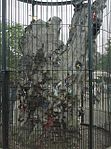Wren House
Christopher Wren buildings in LondonHouses in the Royal Borough of Kensington and ChelseaKensington PalaceRoyal residences in the United Kingdom
Wren House is a house in the grounds of Kensington Palace in London. Wren House has been occupied by Prince Edward, Duke of Kent, one of Queen Elizabeth II's cousins, since 1978.When Kensington Palace was made the Royal Residence, architect Christopher Wren was tasked to expand the existing structure. He added a cluster of cottages that included: Wren House; Ivy Cottage, the former home of Princess Eugenie of York; and Nottingham Cottage, the former home of Prince Harry, Duke of Sussex.
Excerpt from the Wikipedia article Wren House (License: CC BY-SA 3.0, Authors).Wren House
Palace Avenue, London South Kensington (Royal Borough of Kensington and Chelsea)
Geographical coordinates (GPS) Address Nearby Places Show on map
Geographical coordinates (GPS)
| Latitude | Longitude |
|---|---|
| N 51.50594 ° | E -0.18898 ° |
Address
Nottingham Cottage
Palace Avenue
W8 4PZ London, South Kensington (Royal Borough of Kensington and Chelsea)
England, United Kingdom
Open on Google Maps









